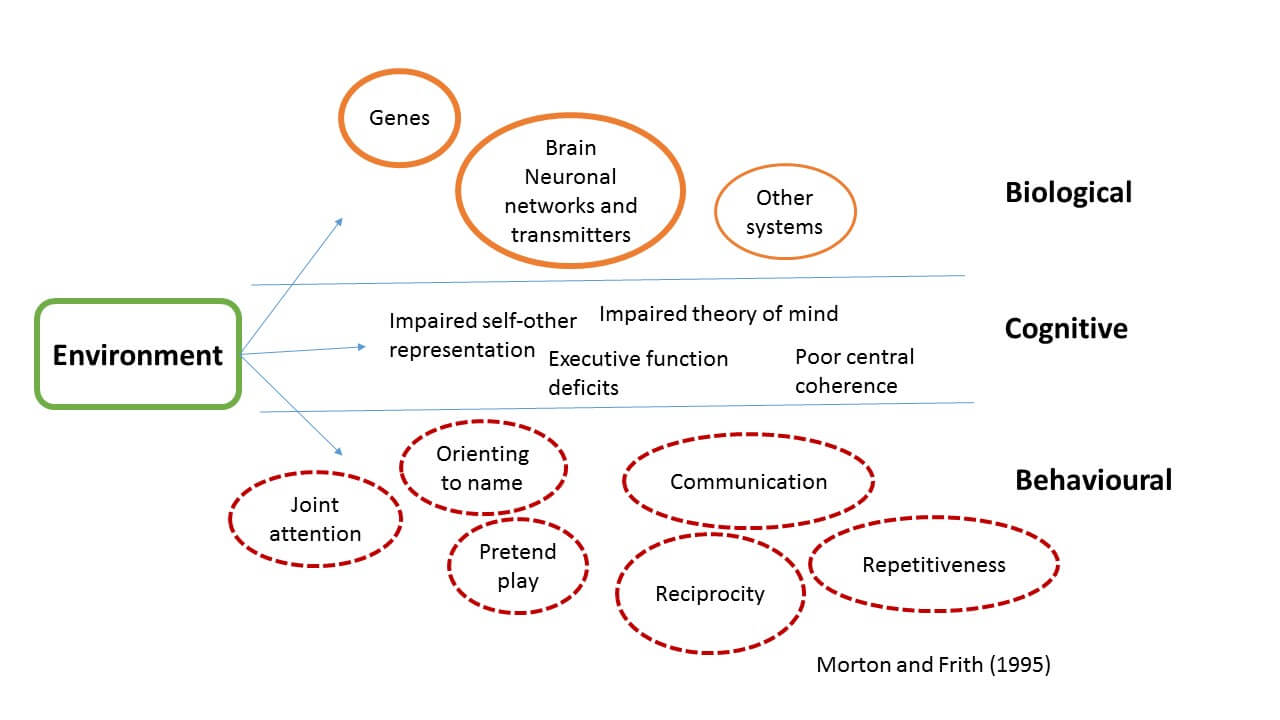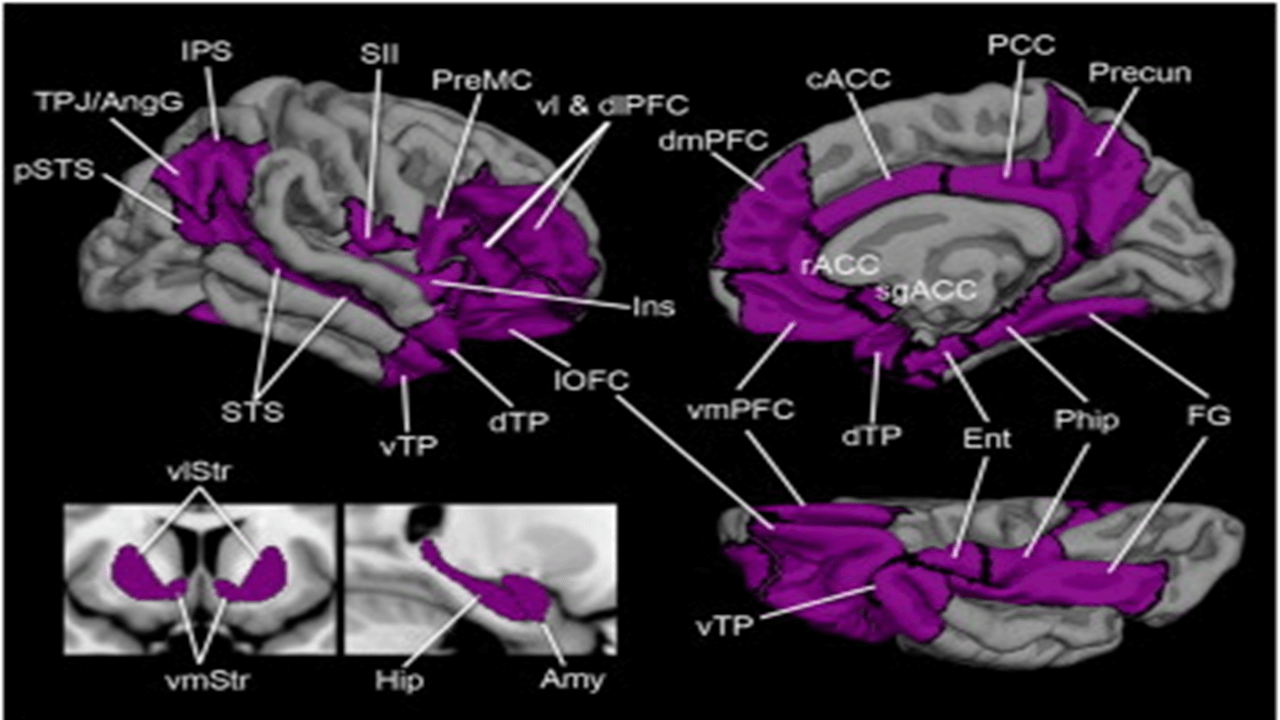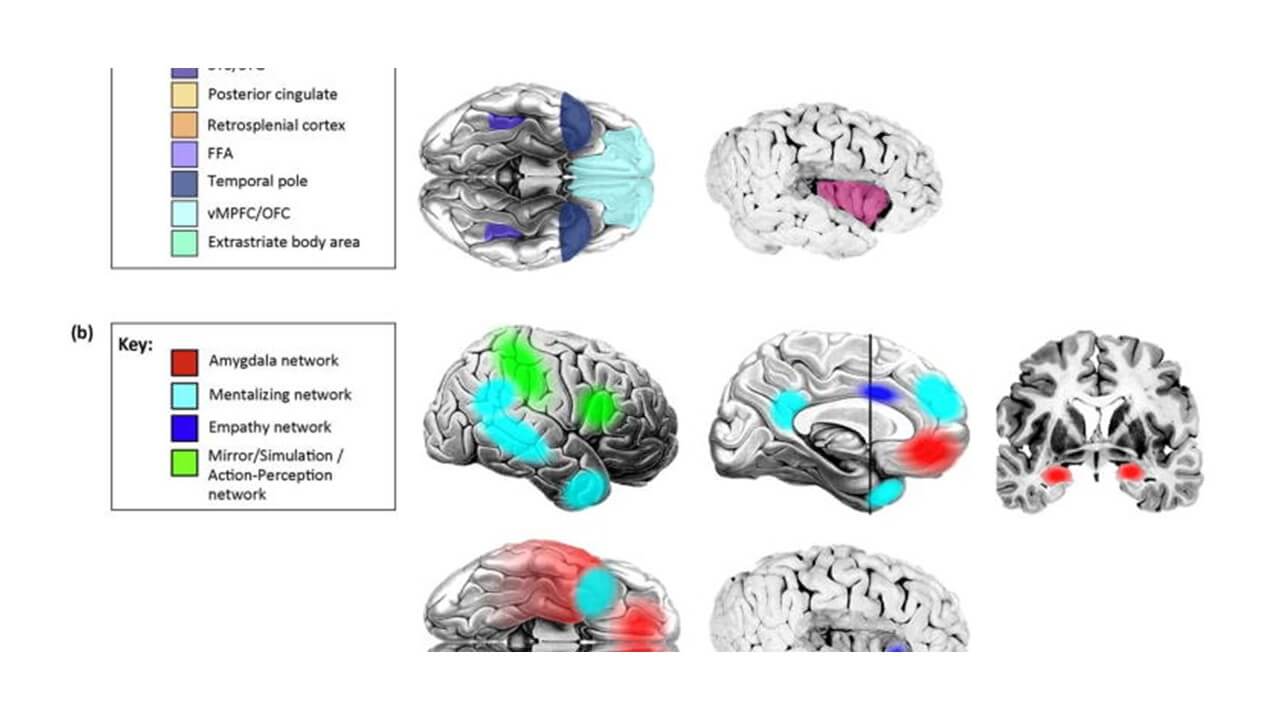Being social feels so easy to most of us; we only realise the complexity of it when we try to understand and help those who have difficulties being social. Most of what we feel and do to be social happens at a behavioural level, some of which is almost automatic or learnt, but a lot of it is supported by cognitive processes. These processes help us perceive and understand others’ actions and thoughts, and flexibly modify our thoughts and feelings as situations change. These behavioural and cognitive processes are underpinned by the structure and function of our brain. A simple causal scheme for social behaviour[i] would look something like:

The social brain is a network of brain regions that specialise in social thinking and actions. The identity of this network is mostly based on:
- observing an increase in activation in neuroimaging studies of healthy adults engaging in a variety of social cognitive tasks (e.g., recognizing familiar people, evaluating whether they are trustworthy or not, or making inferences about their thoughts and intentions), and
- neuroimaging of patients with impairments in social cognition (e.g., diminished empathy or warmth towards others, lack of understanding others׳ intentions)[ii],[iii].
This network is widespread in the brain and includes cortical areas such as orbitofrontal cortex, superior temporal sulcus, temporoparietal junction, fusiform face are and subcortical structures, such as amygdala[iv].
Social cognitive processes and brain regions[v]
| Social cognitive processes | Brain regions activated |
| Sensory processing | Superior colliculus
Fusiform gyrus
|
| Reward evaluation | Amygdala (also discriminating signal from noise, threat from reward, or friend from foe and thereby guiding adaptive interpersonal behaviour)
Orbitofrontal cortex Ventral striatum |
| Representation of perceived action (making sense of other’s actions) | Mirror neurons
Premotor cortex |
| Motivation | Anterior cingulate cortex |
| Theory of mind | Temporoparietal junction
Medial frontal cortex Posterior cingulate |
| Empathy and moral emotions | Insula
Ventromedial prefrontal cortex |
| Social reasoning | Prefrontal cortex |
| Social regulation | Prefrontal cortex
Anterior cingulate cortex |
| Abnormalities of connectivity can cause dysfunction similar to ASD e.g. up to 30% of patients with agenesis of corpus collosum have ASD and social dysfunction iii. | |
Here is a picture to show the extant of the “social brain” (in purple):

And here is a representation of the four key networks:

The functions of the amygdala network range from triggering emotional responses to detecting socially salient stimuli to social affiliative behaviours. A second is the so-called mentalising network, a collection of structures activated by thinking about the internal states of others. A third is recruited when individuals empathize with others. A fourth network is activated during observation of the actions of others, including their emotional expressions. Note that, for simplicity and clarity, not all regions implicated in the networks are shown; several networks also involve other subcortical and brainstem structures that are not illustrated hereiii.
Levels of ‘social’ iii
Social functioning is broader than social behavior in that it refers to the long-term, contextualized ability of an individual to interact with others (e.g., a person’s behavior within a community over the past months). In principle, the relationship between the different levels of ‘social’ is straightforward:
- the social brain implements social cognition,
- which in turn causes social behavior,
- which in turn constitutes social functioning when integrated over time and context.
However the relationships between these different levels (social functioning, social behavior, social cognition, social brain) are not unidirectional: for instance, altered social functioning over time results in changes in brain and cognition[vi].
Neuropathology[vii]
Most of the information about the changes seen in ASD comes from adult brain studies and most of these studies explore specific brain areas only. So, while the findings do tell us something about the type of changes that underlie cognitive and behavioural impairments in autism, the findings are still largely associations rather than giving us a temporal view of causality. The most consistent and apparent alterations localize in the limbic system and cerebellum; however, more subtle examinations and preparations have identified abnormalities in cerebral neocortex and other brain structures.
Some of the key findings are:
- neurons in the hippocampus and amygdala are smaller and more densely packed compared with those in control subjects
- The hippocampus also shows distorted cytoarchitecture and heterotopia and, on a neuronal level, reduced dendritic arborization
- decreases in the size and number of Purkinje cells in the cerebellum (The classical role of the cerebellum is its involvement in motor control and learning, and there is some suggestion of weak motor coordination in ASD patients. However, higher functions of the cerebellum and its connections to cerebral cortex are becoming increasingly recognized, and it is now believed that the cerebellum may play a role in social and emotional processing, language, and cognition.
- Multifocal cortical pathology, such as altered cytoarchitecture in the anterior cingulate cortex, posterior cingulate cortex, fusiform gyrus, and prefrontal cortex.
- On a quantitative level, minicolumn organization is perturbed in a number of cortical regions, with increased density and decreased size of minicolumns in ASD.
- At the macroscopic level, macrocephaly is seen in pre-school children with ASD; brains are heavier than controls. The head size differences become less marked with age.
- In neurochemistry, abnormal neurotransmitter levels have been found in ASD. Elevated levels of serotonin in blood have been reported for up to 45% of ASD subjects. Serotonin signaling mediates many neurodevelopmental processes including neurogenesis, cell migration, cell survival, synaptogenesis, and plasticity.
A unifying genetic-neuropathological paradigmv
One unifying concept consistent with the genetic and neuropathological abnormalities found in ASD patients broadly fits within the narrative of a “developmental disconnection syndrome”, in which long-range neural connections between normally cooperative brain regions fail to fully form, with a corresponding abundance of abnormal short-range connections. Cortical abnormalities, such as patches or migration defects, increased synaptic spine density, and increased minicolumn density, may reflect this abnormal organization. As a result, the integration of information in the frontal lobe (incidentally, one of the focal points of cerebral pathology) would become disorganized.
[i] Morton, J., & Frith, U. (1995). Causal modelling: a structural approach to developmental psychopathology. Manual of developmental psychopathology, 1, 357-390.
[ii] KevinC.Bickart, BradfordC.Dickerson and LisaFeldmanBarrett. The amygdala as a hub in brain networks that support social life. Neuropsychologia63(2014)235–248 . http://dx.doi.org/10.1016/j.neuropsychologia.2014.08.013
[iii] Kennedy DP and Adolphs R. The social brain in psychiatric and neurological disorders. Trends Cogn Sci. 2012 Nov; 16(11): 559–572.
[iv] Mayada Elsabbagh and Mark H. Johnson. Autism and the Social Brain: The First-Year Puzzle. Volume 80, Issue 2, 15 July 2016, Pages 94–99. http://dx.doi.org/10.1016/j.biopsych.2016.02.019
[v] Adolphs R. The social brain: neural basis of social knowledge. Annu Rev Psychol. 2009;60:693-716. doi: 10.1146/annurev.psych.60.110707.163514.
[vi] Eisenberger NI, Cole SW. Social neuroscience and health: neurophysiological mechanisms linking social ties with physical health. Nat Neurosci. 2012;15:669–674
[vii] Chen, J. A., Peñagarikano, O., Belgard, T. G., Swarup, V., & Geschwind, D. H. (2015). The emerging picture of autism spectrum disorder: genetics and pathology. Annual Review of Pathology: Mechanisms of Disease, 10, 111-144.
Genetics of autism<PREVIOUS PAGE NEXT PAGE>What is social cognition?

